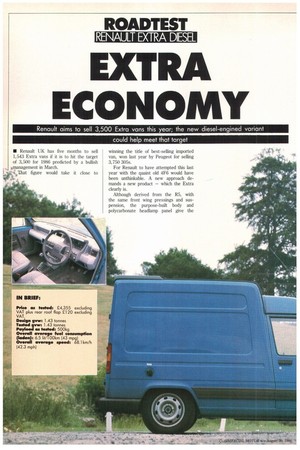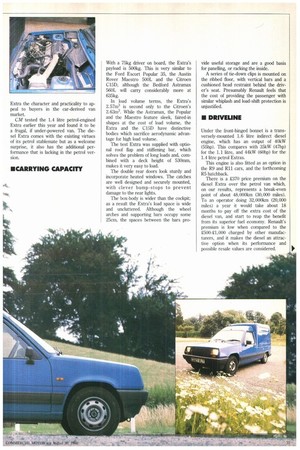EXTRA CONOMY
Page 38

Page 39

If you've noticed an error in this article please click here to report it so we can fix it.
Renault aims to sell 3,500 Extra vans this year; the new diesel-engined variant could help meet that target
• Renault UK has five months to sell 1,543 Extra vans if it is to hit the target of 3,500 for 1986 predicted by a bullish management in March.
1:'That figure would take it close to
winning the title of best-selling imported van, won last year by Peugeot for selling 3,750 305s.
For Renault to have attempted this last year with the quaint old 4F6 would have been unthinkable. A new approach demands a new product — which the Extra clearly is, Although derived from the R5, with the same front wing pressings and suspension, the purpose-built body and polycarbonate headlamp panel give the Extra the character and practicality to appeal to buyers in the car-derived van market.
CM tested the 1.4 litre petrol-engined Extra earlier this year and found it to be a frugal, if under-powered van. The diesel Extra comes with the existing virtues of its petrol stablernate but as a welcome surprise, it also has the additional performance that is lacking in the petrol version. With a 75kg driver on board, the Extra's payload is 500kg. This is very similar to the Ford Escort Popular 35, the Austin Rover Maestro 500L and the Citroen C15D, although the Bedford Astramax 560L will carry considerably more at 635kg.
In load volume terms, the Extra's 2, 57m3 is second only to the Citroen's 2.63m3. While the Astramax, the Popular and the Maestro feature sleek, faired-in shapes at the cost of load volume, the Extra and the C15D have distinctive bodies which sacrifice aerodynamic advantage for high load volume.
The test Extra was supplied with optional roof flap and stiffening bar, which solves the problem of long loads and, combined with a deck height of 530mm, makes it very easy to load.
The double rear doors look sturdy and incorporate heated windows. The catches are well designed and securely mounted, with clever bump-stops to prevent damage to the rear lights.
The box-body is wider than the cockpit; as a result the Extra's load space is wide and uncluttered. Although the wheel arches and supporting bars occupy some 25cm, the spaces between the bars pro
vide useful storage and are a good basis for panelling, or racking the inside.
A series of tie-down clips is mounted on the ribbed floor, with vertical bars and a cushioned head restraint behind the driver's seat. Presumably Renault feels that the cost of providing the passenger with similar whiplash and load-shift protection is unjustified.
• DRIVELINE
Under the front-hinged bonnet is a transversely-mounted 1.6 litre indirect diesel engine, which has an output of 40kW (55hp). This compares with 35kW (47hp) for the 1.1 litre, and 44kW (60hp) for the 1.4 litre petrol Extras.
This engine is also fitted as an option in the R9 and R11 cars, and the forthcoming R5 hatchback.
There is a £.370 price premium on the diesel Extra over the petrol van which, on our results, represents a break-even point of about 48,000km (30,000 miles). To an operator doing 32,000km (20,000 miles) a year it would take about 18 months to pay off the extra cost of the diesel van, and start to reap the benefit from its superior fuel economy. Renault's premium is low when compared to the 250041,000 charged by other manufacturers, and it makes the diesel an attractive option when its performance and possible resale values are considered.












































































